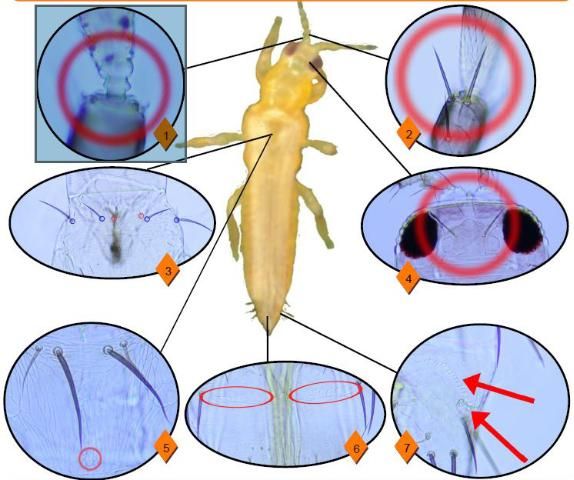Morphology

Credit: Jeffrey D. Cluever, UF/IFAS
- Extremely convex pedicel at base of antennal segmentIII.
- Setae arising from antennal segment II not forming stout spines.
- Four major setae on anterior margin of pronotum (blue); 2 minor setae (red).
- Ocellar III setae not arising between posterior ocelli.
- Metanotal campaniform sensilla present.
- Comb on tergite VIII interrupted in center.
- Ctenidium (upper arrow) on tergite VIII anterior to spiracle (lower arrow).
Appearance
Egg
Small and embedded in foliage. Unlikely to be seen.
Larvae
Light in color, wingless, appear similar to other Frankliniella thrips, usually not identified.
Pupal Stages
Presence of wing buds with straight antennae (prepupa) or with antennae pulled back over the head (pupa). These are not typically identified.
Adult
Yellow in color. As with other Frankliniella spp., it has four major setae on the anterior margin of the prono-tum. Also indicative of Frankliniella spp., it has ctenidia (oblique rows of fine hairs [often appearing as dots]) on tergite VIII anterior to the spiracles.
Other Diagnostic Features
Pedicel (base of antennal segment III) is strongly convex, though not quite forming a flange. Ocellar III setae (large pair nearest the ocelli) do not arise between pos-terior ocelli. Metanotal campaniform sensilla (small sensory structures that appear like two small dots) present. The comb on tergite VIII (row of microtrichia) is interrupted in the center.
Life Cycle
F. tritici exhibits all the life stages common to terebrantian thrips: the egg, larva I, larva II, prepupa, pupa, and the adultstage. The length of each life stage and number of eggs laid per female varies according to temperature and host plant.
In a study in South Carolina seasonal averages were as follows:
- The female lays an egg into the plant foliage; 3.3 days later it hatches.
- The larva I and II feed for 2.0 and 2.4 days respectively.
- The quiescent prepupa and pupa last 1.1 and 2.4 days respectively.
Host Range and Distribution
Wide host range, including asparagus, brambles, chrysanthemum, cotton, peach, rose, rye, soybean, strawberry, tomato, and various wild species of plants.
Origin
Eastern North America.
Global Distribution
Asia, Caribbean, Europe, and North America.
United States
Primarily east of the Rockies.
Florida
Northern.
Types of Injury
This species is primarily a flower feeder, so most damage is seen on the flower or fruit. If feeding occurs on the foliage it may cause silvering. Feeding on the bloom can cause petal browning or malformed fruit. Feeding on the fruit can cause scarring or bronzing. Occasionally one may see oviposition blisters where the female has laid her eggs.